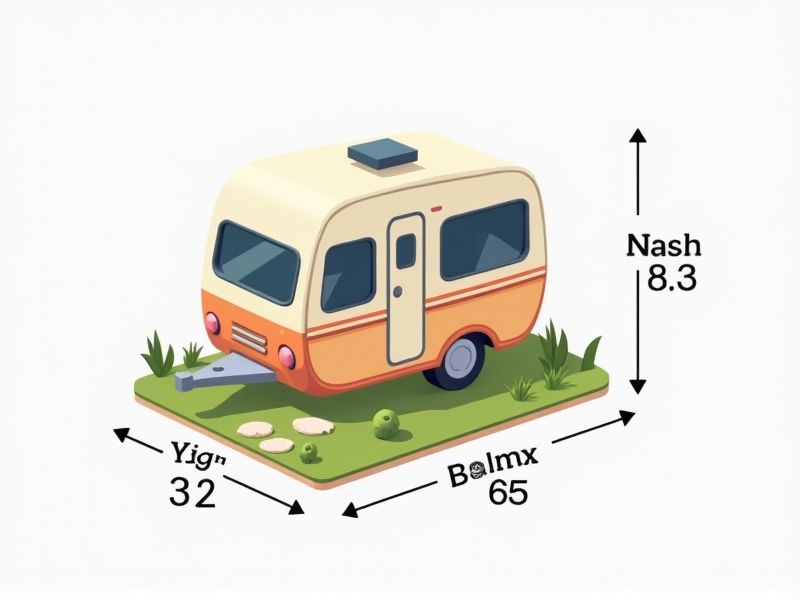
Standard camper dimensions vary based on type, but most travel trailers typically range from 10 to 35 feet in length and 7 to 8 feet in width, excluding slide-outs. For example, teardrop campers may measure as small as 8 feet long, while fifth-wheel campers can exceed 40 feet. The average interior height is usually between 6.5 and 7 feet, ensuring most adults can stand comfortably. Knowing these standard sizes helps you choose a camper that fits both your needs and your towing vehicle's capabilities.
Length
The standard length of a camper typically ranges from 10 to 35 feet, accommodating various travel needs and comfort levels. Smaller models, around 10 to 20 feet, are ideal for solo travelers or couples, providing easy towability and compact living spaces. Medium-sized campers, measuring 21 to 25 feet, often include additional amenities such as bathrooms and kitchenettes, making them suitable for families. Larger campers, over 26 feet, offer more luxurious features and greater storage capacity, perfect for longer trips or larger groups.
Width
When selecting a camper, the standard width typically ranges between 7 to 8.5 feet, with many models designed for optimal space efficiency and comfort. A broader width can enhance interior livability, offering room for amenities like a full kitchen and sleeping areas that accommodate multiple occupants comfortably. For those considering towing, ensure that your vehicle can handle the wider load, as it may impact driving dynamics and overall safety. You can significantly improve your camping experience by choosing a camper that balances width with maneuverability, making it suitable for various camping terrains.
Height
The standard height for most campers ranges from 9 to 12 feet, providing an optimal balance between headroom and aerodynamics. When considering a camper, ensure the interior height meets your needs, typically averaging around 6.5 feet for comfortable mobility. Taller individuals may prefer models exceeding 7 feet in height, enhancing ease of movement and livability. If you plan to travel in varying terrains, be mindful that the overall height can affect your camper's clearance and handling.
Wheelbase
The standard wheelbase for campers typically ranges between 118 to 170 inches, impacting stability and maneuverability. A longer wheelbase often provides better handling on highways and facilitates a smoother ride, making it ideal for extended road trips. Conversely, a shorter wheelbase offers enhanced agility, which is particularly beneficial for navigating tight spaces and winding roads. When choosing a camper, consider how the wheelbase aligns with your travel preferences and the types of adventures you envision.
Interior Space
When considering a standard camper, the interior space is paramount for comfort and functionality. Most models range between 18 to 30 feet in length, providing layouts that can accommodate up to six people. Key features often include a dedicated sleeping area, dining space, and a kitchenette equipped with essential appliances. Maximizing storage is also crucial, with thoughtful designs incorporating cabinets and compartments, ensuring that your gear is organized and accessible.
Ground Clearance
Ground clearance is a critical specification for campers, with an ideal height typically ranging from 8 to 12 inches. This measurement affects maneuverability and off-road capability, allowing vehicles to navigate uneven terrain without the risk of undercarriage damage. Many campers prioritize a higher ground clearance to enhance stability and improve approach and departure angles, essential for tackling challenging landscapes. When choosing a camper, consider how the ground clearance can impact your travel experience, especially if you plan to explore rugged or remote locations.
Slide-Out Dimensions
The Slide-out dimensions of campers typically range from 1 to 3 feet in depth, providing substantial additional living space when extended. Most modern RV slide-outs can extend up to 12 feet in width, offering various layouts to maximize your comfort and utility. These expandable sections significantly enhance a camper's overall livability, accommodating more furniture and optimizing areas for cooking, dining, and relaxation. When considering a camper, evaluating slide-out functionality and dimensions is crucial for ensuring it meets your specific needs and preferences.
Door Size
The standard door size for a camper is typically around 24 to 30 inches in width and 72 to 80 inches in height, providing ample access for entry and exit. Ensuring proper door dimensions is crucial for accommodating various mobility needs and enhancing user convenience. A well-constructed door with durable materials can greatly improve your camper's insulation and security, with most models featuring lightweight yet sturdy options. When selecting a camper, consider not only the door size but also the ease of operation, especially in tight spaces or adverse weather conditions.
Cargo Area Size
The cargo area size is a crucial factor for selecting a camper, as it directly impacts the storage capacity and overall functionality. Many models offer a cargo area ranging from 50 to 150 cubic feet, accommodating everything from camping gear to recreational equipment. Efficient organization systems within the cargo space can enhance accessibility, allowing you to maximize the use of every cubic inch. When considering your options, assess your specific storage needs and choose a camper that provides a cargo area tailored to your adventures.
Roof Thickness
When selecting a camper, the roof thickness significantly impacts insulation and durability. Most high-quality campers feature a roof thickness ranging from 1.5 to 3 inches, providing enhanced protection against harsh weather conditions. A thicker roof not only reduces indoor heat loss during winter but also minimizes heat gain in summer, promoting a more comfortable living environment. Choosing a camper with optimal roof thickness can lead to improved energy efficiency, saving you money on heating and cooling expenses over time.
